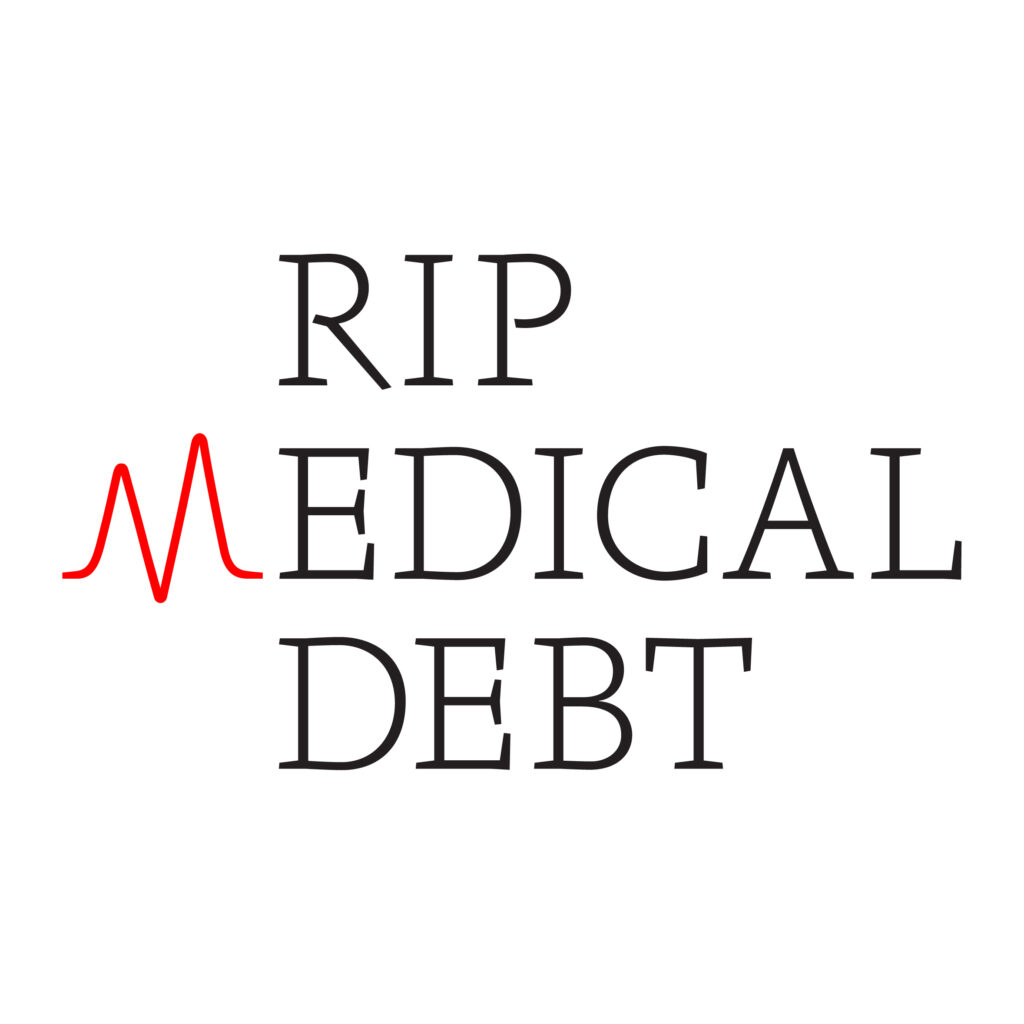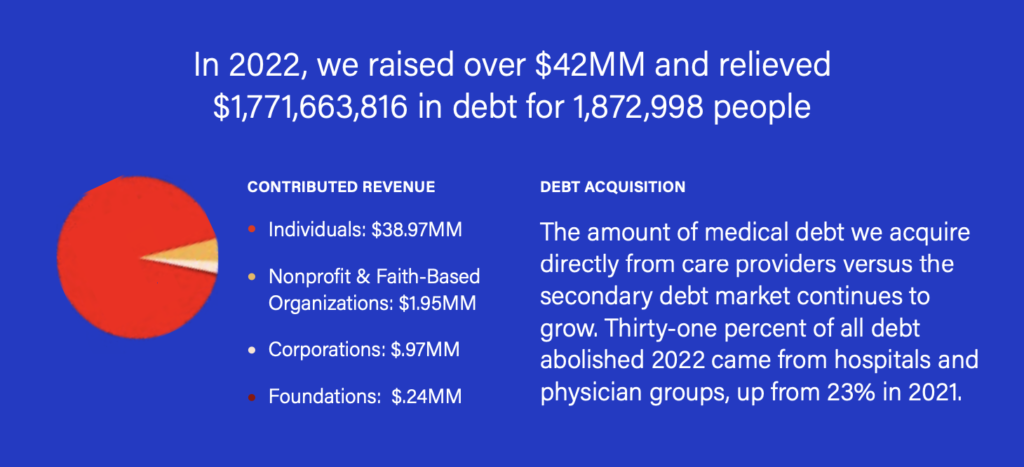
Over the last decade, a non-profit organization called RIP Medical Debt has quietly emancipated millions of Americans from the crippling burden of healthcare bills that they simply cannot afford to pay.
How?
By using funds contributed by donors large and small to buy debts for pennies on the dollar—at the same prices that collections agencies get—and then simply cancelling those debts.
Since its founding in 2014, RIP Medical Debt has paid off more than $10.4 billion on behalf of more than 7.1 million people. The group is also working to push the issue of medical debt onto the political centerstage.
“We are working not only to shift the way we think about medical debt, but change the lives of people living in its shadow,” the organizations says on its website.
A “Uniquely American Injustice”
As medical costs soar–and corporate profit-taking in healthcare continues unabated—more and more Americans are falling into medical debt.
RIP Medical Debt estimates that more than 100 million Americans—that’s roughly one in three– have struggled with medical debt at some point in their lives. More than half of all US adults (54%) currently have unpaid medical bills, or have had medical debt over the last 5 years. The vast majority—over 90% of those surveyed by the organization–have some form of medical insurance. But the plans are seldom adequate to cover all the costs incurred by a serious illness or accident.
Burdensome medical debt disproportionately affects Black people, as well as poor people of all races and ethnicities who are already struggling financially.
Among people living on less than $60,000 per household per year—which is the oft-cited “400% of the federal poverty level” threshold—67% have medical bills they cannot pay, according to a study conducted by RIP Medical Debt.
More than half of all US adults (54%) currently have unpaid medical bills, or have had medical debt over the last 5 years. The vast majority—over 90% of those surveyed by the organization–have some form of medical insurance.
And that’s the people who have health insurance. Among those in the under-$60,000 bracket who are uninsured, 88% are in medical debt.
The top three reasons for medical debt are: surgery/medical procedure (27%), emergency care (25%), and hospitalization (16%). The organization notes that all of these reasons reflect non-elective, necessary, and often unexpected episodes of medical care.
Putting it bluntly, medical debt ruins lives. It is the number one reason that people turn to crowd-funding campaigns, and the number one reason for declaring personal bankruptcy. It exhausts family savings, and wrecks credit ratings. In some cases, it leads to wage garnishments and liens on peoples’ homes.
Medical debt is a major factor in keeping impoverished people poor, and driving middle class people into poverty. The organization notes that more than half of Americans say getting a bill they can’t afford is as scary as a serious diagnosis itself.

An Innovative Vision
RIP Medical Debt was founded in 2014 by two former debt collections executives, Jerry Ashton and Craig Antico, who said they were inspired by the 2011 Occupy Wall Street protest movement to take on the challenge of finding a viable solution for people drowning in medical debt.
With support and know-how from dozens of financial services veterans, Ashton and Antico developed a system for buying up portfolios of medical debt from hospitals and healthcare systems at drastically reduced prices, filtering the debt records through algorithms to identify indebted people who are least able to pay off their debts, and then simply abolishing these debts rather than pushing for collection.
The group’s system picks up debts owed by people who are at or below 400% of the federal poverty level, or who have medical debts exceeding 5% of their total annual income. The process is completely anonymous and unbiased, in the sense that individuals who are in debt cannot apply to RIP Medical Debt for relief, and the organization does not target specific individual cases.
In fact, recipients of the group’s debt absolution only find out about it after their debts have been cancelled. The process is compliant with HIPAA and the Fair Credit Reporting Act. Recipients of debt relief do not incur any tax burden, and the organization works diligently to repair damaged credit scores its recipients.
Since its founding in 2014, RIP Medical Debt has paid off more than $10.4 billion on behalf of more than 7.1 million people. The group is also working to push the issue of medical debt onto the political centerstage.
RIP Medical Debt operates completely within the regulations that govern the debt collections industry and buys debt at the same reduced rates as standard collections agencies. But it turns the collections game on its head by foregoing the profit motive. The group estimates that every dollar from donors translates into $100 in debt relief.
Praised for its integrity and transparency, RIP Medical Debt achieved a rating of 100 out of 100 from Charity Navigator.
Amplifying the Impact
Medical debt is a “uniquely American injustice,” said Allison Sesso, the organization’s current president and CEO, in an interview with the Rotary Club. RIP Medical Debt has positioned itself as “a source of justice in an unjust healthcare financing system, and a moral force for systemic change.”

Prior to joining RIP Medical Debt in 2020, Sesso was the executive director of the Human Services Council of New York (HSC), an organization representing 170 non-profit groups that collectively provide 90% of non-government human services in New York City. She leads a lean but motivated team of 40 employees, many of whom have strong expertise in financial services and big data analytics.
The integrity of the group’s mission and the professionalism with which it carries out its work has attracted a huge base of contributors, includes some very high-profile donors.
In 2020, MacKenzie Scott, the former wife of Amazon founder Jeff Bezos, contributed $50 million which, according to RIP Medical Debt’s 10-to-1 dollar conversion, resulted in the absolution of $500 million in unpaid healthcare expenses—a major amplification of impact.
Several municipalities and hospital systems have also stepped up. Earlier this year, the government of Cook County, Illinois, opted to invest a portion of its Covid-19 stimulus funds with RIP Medical Debt in order to cancel nearly $80 million in medical debt incurred by roughly 72,000 of county’s residents. This included a number of medical professionals and healthcare workers struggling with medical debt, in some cases, owed to the very institutions in which they work.
Last Spring, New Orleans mayor LaToya Cantrell announced a plan to allocate $1.3 million of the city’s American Rescue Plan Act (ARPA) funds as a donation to RIP, with the goal of absolving over $100 million in healthcare debt on behalf of city residents. Similarly, the local government of Oakland County, Michigan, announced that it was putting $2 million of its ARPA funds into RIP, to alleviate $200 million in debt currently burdening some of the county’s poorest residents.
Sesso stressed that RIP Medical Debt is working at both the macro- and microeconomic level. On one hand, unpaid medical debt is a major societal issue, and solving it will require major policy changes at the federal, state, and local levels.
On the other hand, it is a deeply personal problem causing tremendous financial and emotional strain on people and their families. Sesso emphasized the little-appreciated fact that debt burdens are, in and of themselves, social determinants of ill health.
END







